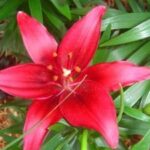Have you noticed how many homes have one or two small trees planted for accent? Not large enough for shade, not tall enough for impressive height, but just a medium-sized tree. It may be a flowering one notable for its blooms, or one with an interesting foliage or shape.
Drive down streets where the houses have been built within the past few years and notice the number of Wild Olive Trees. (Cordia boissieri). They are sometimes called Anacahuita or Anacahuite. It is said that in Mexico they are called Anacahuitl from the Nahuatl amacuahitl, or paper tree, because the crinkly white flowers with gold at the centers of the petals are thin as onion-skin paper.
These trees bloom several times a year and are almost everblooming if healthy. The olive-like fruit is eaten in some parts of Mexico. A jelly made from the fruit is used as a remedy for coughs and colds.
The red bud tree makes another pretty accent, but unless plenty of humus or leaf mold is kept in the soil these often die within a few years, here.
The bottle brush tree, if the right kind is chosen and if kept to a good shape, can be beautiful as an accent shrub or small tree. Callistemon lanceolatus with bright green foliage and the new growth tipped with reddish leaves is called weeping bottle brush. The blooms are like slender brushes. Callistemon rigidus is another bottle brush with dark green linear foliage.
The orchid tree is also sometimes used as an accent tree. But it is hard to keep shapely and does freeze back if a hard freeze comes. In early spring, the flowers are profuse on the almost leafless branches. Purple, white and pink flowered trees are the most popular.
The loquat tree is used as an accent tree occasionally. These produce heads of small white flowers in the winter followed by yellow fruit – often called Japanese Plum.
At the Sam Hausman house at 601 Del Mar, there is an anacua tree which is kept formally clipped and is interesting as an accent tree. This tree grows large if left alone. It has rough, rather small leaves, cluster of white flowers, followed by yellow to orange berries often called sugar berry. The fruit is edible, Ehretia anacua is the scientific name. Anacua or “knock-a-way” are common names.
Several Erythrina trees are quite ornamental. The rosy red firecracker – like blooms are produced on leafless branches in early spring. Erythrina aborens or coral tree is the name. Erythrina crista galli is another of these trees which is known here as fireman’s cap.
Erythrina indica or tiger’s claw tree is another variety of the coral tree that is most attractive when in bloom. This tree is larger than the arborens. The flowers are an orange red, but it will freeze here.
The jacaranda, royal poinciana, retama, ligustrum, silk oak. Texas ebony, Brazilian pepper tree, the golden rain tree and a number of others may be used as accent trees, but some get too large for this purpose and a number have faults of falling leaves, fruit or seed pods which makes them less desirable.
Now is the time of year to decide on new trees for landscape use, and flowering trees which are rather small make excellent choices for accent. Some are more readily planted in January or February when they are dormant; others can be planted earlier if available.





